During this first tumultuous summer of the Trump Presidency, it has been almost possible to mistake events in America’s cities for a constant loop of scenes from Spike Lee’s 1989 movie, “Do the Right Thing.” The chaotic and deadly events in Charlottesville were followed, a week later, by a largely peaceful anti-racism march in Boston, which both dwarfed a pathetic concurrent gathering of white supremacists and inspired hope that we might make it through the month without more violence in the streets. That hope proved sustainable through a shaky détente in Phoenix, where Trump spoke in defense of the former sheriff and convicted racial profiler Joe Arpaio. It endured through last Saturday, when a planned right-wing demonstration in San Francisco was cancelled, and survived most of Sunday, when roughly four thousand anti-racism protesters conducted a peaceful demonstration across the bay, in Berkeley’s Martin Luther King, Jr., Civic Center Park. But it fractured the moment that contingents identified as anarchists and Antifa radicals slipped into the crowd and began attacking right-wing protesters who had assembled there under the banner of free speech. (Six months ago, the University of California campus at Berkeley, the nucleus of the Free Speech Movement of the nineteen-sixties, was thrust into the headlines when a group of protesters smashed windows and set fires in order to prevent the right-wing provocateur Milo Yiannopoulos from speaking there.)
Following Donald Trump’s first, inept remarks on the tragedy in Charlottesville, his false even-handedness regarding the violence there has proven politically disastrous. Republicans who have acceded to Trump’s numerable previous violations of ethics and protocols felt the need to make their strongest, albeit still fairly mild, criticisms of the Administration. Trump’s own Secretary of State, Rex Tillerson, noted on Sunday, in a striking interview with Chris Wallace, on Fox News, that on issues of values Trump “speaks for himself.” For those who are concerned that the moral elasticity of conservatives will continue to abet Trump’s behavior, this was an encouraging sign. But the images out of Berkeley—outnumbered right-wing protesters being pepper-sprayed by counter-demonstrators, one person lying on the ground while a black-clad group punched his face and torso—will be held up by many on the right as evidence that Trump was correct about the blame falling on “many sides.” Where, they will ask, is the equivalent portion of outrage from the media, from the left, from anyone who claims to respect the First Amendment?
These are not equal pursuits. The Antifa demonstrators, unlike the white-supremacist factions that gathered in Virginia, do not represent a tradition of murderous violence in this country; they are not heirs to the most embittered segments of the wrong side of a conflict that ripped the country at its seams during the Civil War, or to groups that orchestrated the lynching of four thousand black people in the decades after that side’s defeat. Nevertheless, there is no escaping the fact that the elements that lashed out in Berkeley were both morally wrong and politically vacuous. And their timing could not have been worse. As Josh Marshall points out, at Talking Points Memo, these situations tend to work to the benefit of reactionaries, not progressives:
This isn’t simply a problem of disparate right-wing groups being able to rationalize their existence more easily. We are in the midst of a Presidency that will manipulate such situations. On Monday, the Attorney General, Jeff Sessions, in keeping with Trump’s primary political objective—the eradication of Barack Obama’s Presidential legacy—formally announced a reversal of restrictions that, following the violence in Ferguson, Missouri, in 2014, the Obama Administration placed on the policy of transferring military-surplus grenade launchers, .50-calibre guns, bayonets, and even armed aircraft to local police departments. This reversal would almost certainly have happened irrespective of the events in Berkeley; just a month ago, Trump, speaking to an audience of law-enforcement officers on Long Island, encouraged them to employ the kinds of tactics that have led to unrest in successive American cities during the past three years. (“Please don’t be too nice,” the President said.) But, in a healthy democracy, or one struggling to remain so, public perception matters. Having ginned up public fear about law and order from his first statements as a candidate, repeatedly citing phantom crime statistics both during the campaign and while in the White House, Trump has been the beneficiary of skewed perceptions.
Trump exudes a malign charisma, and witnessing its appeal and the license that it grants him has been destabilizing for a wide swath of the left. Some of Trump’s opponents have said that they are waiting for a Reichstag fire—a false crisis that will be used to justify the Administration’s worst instincts. We have not yet encountered such a moment, but the clear dictate of common sense is that no one should be in the business of providing this President with matches.

